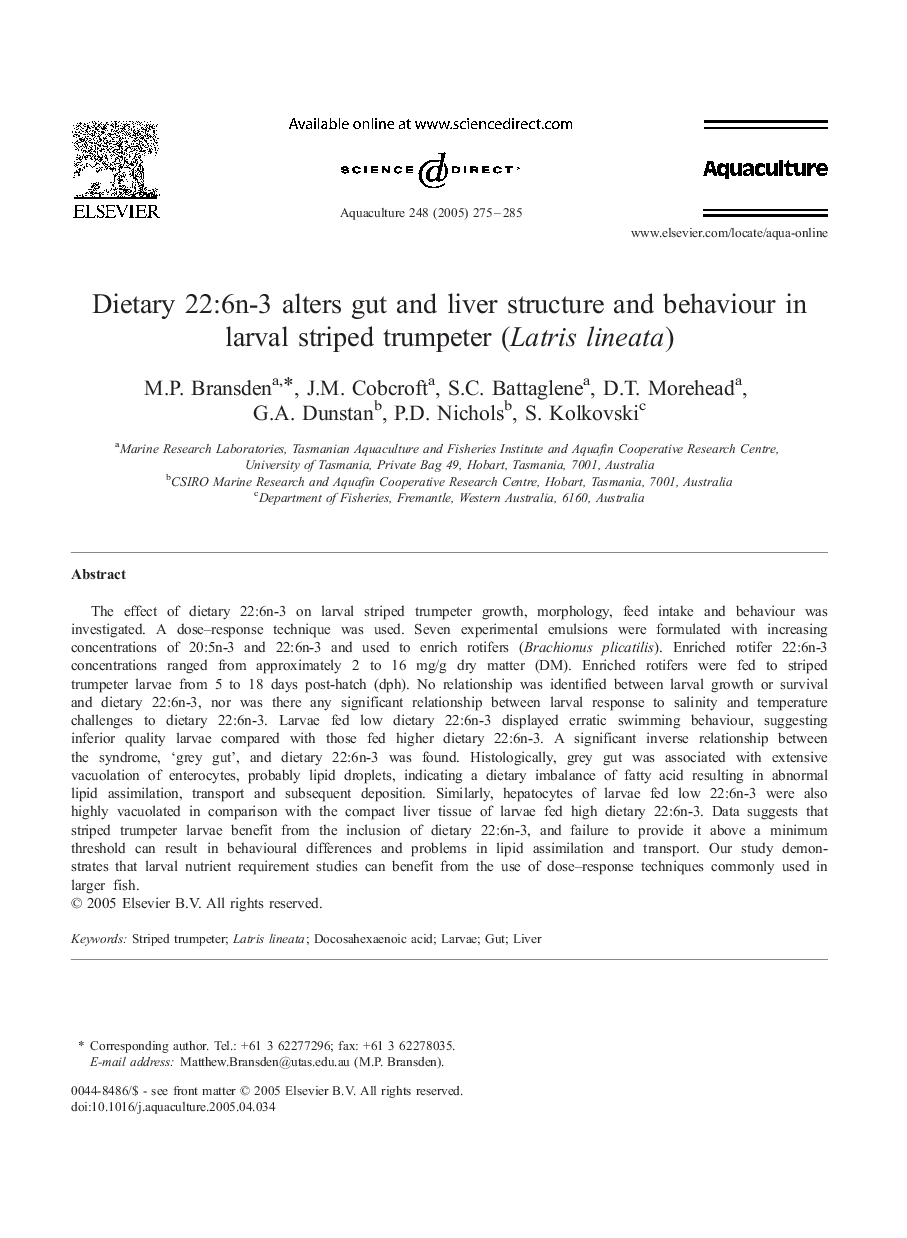| کد مقاله | کد نشریه | سال انتشار | مقاله انگلیسی | نسخه تمام متن |
|---|---|---|---|---|
| 8974832 | 1552994 | 2005 | 11 صفحه PDF | دانلود رایگان |
عنوان انگلیسی مقاله ISI
Dietary 22:6n-3 alters gut and liver structure and behaviour in larval striped trumpeter (Latris lineata)
دانلود مقاله + سفارش ترجمه
دانلود مقاله ISI انگلیسی
رایگان برای ایرانیان
کلمات کلیدی
موضوعات مرتبط
علوم زیستی و بیوفناوری
علوم کشاورزی و بیولوژیک
علوم آبزیان
پیش نمایش صفحه اول مقاله

چکیده انگلیسی
The effect of dietary 22:6n-3 on larval striped trumpeter growth, morphology, feed intake and behaviour was investigated. A dose-response technique was used. Seven experimental emulsions were formulated with increasing concentrations of 20:5n-3 and 22:6n-3 and used to enrich rotifers (Brachionus plicatilis). Enriched rotifer 22:6n-3 concentrations ranged from approximately 2 to 16 mg/g dry matter (DM). Enriched rotifers were fed to striped trumpeter larvae from 5 to 18 days post-hatch (dph). No relationship was identified between larval growth or survival and dietary 22:6n-3, nor was there any significant relationship between larval response to salinity and temperature challenges to dietary 22:6n-3. Larvae fed low dietary 22:6n-3 displayed erratic swimming behaviour, suggesting inferior quality larvae compared with those fed higher dietary 22:6n-3. A significant inverse relationship between the syndrome, 'grey gut', and dietary 22:6n-3 was found. Histologically, grey gut was associated with extensive vacuolation of enterocytes, probably lipid droplets, indicating a dietary imbalance of fatty acid resulting in abnormal lipid assimilation, transport and subsequent deposition. Similarly, hepatocytes of larvae fed low 22:6n-3 were also highly vacuolated in comparison with the compact liver tissue of larvae fed high dietary 22:6n-3. Data suggests that striped trumpeter larvae benefit from the inclusion of dietary 22:6n-3, and failure to provide it above a minimum threshold can result in behavioural differences and problems in lipid assimilation and transport. Our study demonstrates that larval nutrient requirement studies can benefit from the use of dose-response techniques commonly used in larger fish.
ناشر
Database: Elsevier - ScienceDirect (ساینس دایرکت)
Journal: Aquaculture - Volume 248, Issues 1â4, 29 July 2005, Pages 275-285
Journal: Aquaculture - Volume 248, Issues 1â4, 29 July 2005, Pages 275-285
نویسندگان
M.P. Bransden, J.M. Cobcroft, S.C. Battaglene, D.T. Morehead, G.A. Dunstan, P.D. Nichols, S. Kolkovski,